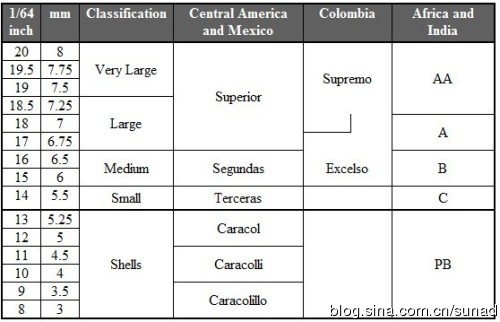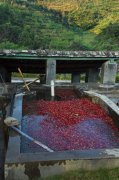10 elements to consider when choosing raw coffee beans in boutique coffee science
The raw bean seller is mainly responsible for grading the coffee beans before selling them to the coffee bean merchant. After the grading is completed, premium coffee beans and boutique coffee beans will be selected, although they will have some defects but do not affect the coffee rating. These defects are not so serious, but they can also cause potential damage to the quality of coffee. Although Cupping is undoubtedly the clearest way to check coffee beans, you can still see how carefully coffee beans are processed by looking at their appearance.
Here are 10 factors to consider when choosing raw coffee beans:
1. The size of raw beans should be very similar. The appearance must be as consistent as possible, and the color should be similar. This project determines the color uniformity after baking and the difference in taste after baking. For example, 17Universe 18, 15apace 16, 13apace 14, etc., because beans with smaller grains are baked at the same time with beans with larger particles, resulting in an uneven baking degree, and therefore, the taste in the cup is uneven. The uneven color of raw beans is attributed to the problem of drying process, while the uneven appearance may be caused by the mixing of beans from different tree species.
Green Coffee Beans Sizing Chart

two。 It must be determined that coffee farmers and processing plants are divided into batches according to the geographical growth areas and tree species of coffee trees. These batches must be harvested separately, processed separately, and tested in their respective cups, before deciding whether they should be mixed and stored in proportion.
3. Washed Arabica raw coffee beans must be uniform and glossy in appearance, and should not be uneven or dark in color. The treatment process of coffee beans plays a decisive role in the quality of raw beans, and the color of coffee beans will be cloudy if not handled properly. Coffee made from bad-looking raw beans won't taste good either.
4. Try to understand the details of the drying process of raw beans, and if the estate puts a lot of effort into the drying process to ensure that the raw beans are properly dried, these efforts will be reflected in the cup. The use of improper balcony exposure or improper use of the dryer can usually be distinguished by the appearance: the rapid drying of the dryer will make the appearance of raw beans muddy, or look brown; the appearance of raw beans has spots, it may be because the drying process is too fast, or the thickness of the balcony is too thin, or the speed of the dryer is too slow. Some people suggest that the raw beans should be exposed on the balcony for a while to dry the skin, then transfer to the dryer, and then take out the balcony exposure for the final drying process, which they believe will help to uniform the color. In addition, some people bake the beans in the dryer every once in a while, and then put them back in the warehouse for storage, so that the moisture content of the beans will be more consistent, which is a very important step. Because the moisture content on the outside of the bean must be different from that on the inside. You can first ask about the temperature used to dry beans, if the product is more than 42 degrees Celsius, it will not be very good.
5. No matter where you buy beans, you need to make sure that the beans are sent to the processing plant as soon as they are harvested, otherwise you are likely to get a cup of overfermented coffee, because the beans begin to ferment as soon as they are picked. Then ask them how to use the fermentation tank? Will the beans floating on the water be picked out? After the past mucosal procedure, are they separated into different sinks according to the hardness of beans? Only manors that spend a lot of time and effort on quality improvement will understand the importance and necessity of these steps. If the de-mucosal procedure and washing treatment are carried out in the same tank at the same time, there will usually be some brown color on the surface of raw beans, and the same will happen on treated overripe beans.
6. Dried raw beans are usually covered with brown silver skins. In Brazil, this situation is called "Fox Bean" and is not included as a defect item. Novice bean pickers generally think that this is a defect, but if you rub the beans with a sieve a little bit, the silver skin will fall off, so this is not a flaw. Immature beans will also have silver skins attached to the surface, but rubbing like the former cannot remove the silver skins. In the washed beans, "Fox Bean" shows a higher acidity, more fruity aroma, and sometimes more Rio flavor. The trend of the taste must be judged by drinking, not by visual observation.
7. Is there a pink silver cover in the cracks or on the surface of the beans? In some areas, this phenomenon is considered a great defect, but most people will ignore it, simply because this item is not listed as the defective bean standard in the coffee bean grading system, so such coffee beans may be classified as "Specialty" and go into the hands of buyers. Beans in this kind of situation are best tested separately from other beans to find out whether the degree of defect is serious.
8. Is it white or dark around the raw beans? The reason is the lack of drying time, or the storage environment is too wet, the performance in the cup is the taste of empty, very boring taste. Whitening around beans can also occur in beans where the drying process is uneven, meaning that one side of the same bean is dried and the other side may be fine. The whitening of beans is caused by oxidation, contact with the ground, or contaminated by sewage.
9. Smell raw beans. Excessive fermentation or soot contamination can be found at this time, and these flavors may become imperceptible after baking.
10. How does it feel to grab a handful of raw beans? If they feel brittle, like glass, they may be too dry or too hot to dry. If you feel too soft and may not dry enough, you must return the beans immediately, because the raw beans under this moisture content are very easy to mildew.
Important Notice :
前街咖啡 FrontStreet Coffee has moved to new addredd:
FrontStreet Coffee Address: 315,Donghua East Road,GuangZhou
Tel:020 38364473
- Prev

Boutique coffee studies the types of coffee beans from all over the world
When you drink coffee, do you notice what kind of coffee beans are ground? There are many varieties of coffee beans with different tastes. At present, most of the coffee beans on the market are distinguished by their origin. Some of the major producing countries and their famous coffee are listed below, and there are professional coffee companies in many countries that roast and grind their own coffee beans and pack them into brand coffee.
- Next

Wet treatment methods and steps for processing Yunnan Coffee beans
As the harvest season is almost over, I would like to add an overview of the coffee processing process. In this blog post, I will introduce to you the steps of wet treatment in Yunnan after coffee picking. After harvest, the berries are either sent directly to the pulp collector (if the harvest is done well), or concentrated in a siphon tank filled with water. The berries are here.
Related
- Beginners will see the "Coffee pull flower" guide!
- What is the difference between ice blog purified milk and ordinary milk coffee?
- Why is the Philippines the largest producer of crops in Liberia?
- For coffee extraction, should the fine powder be retained?
- How does extracted espresso fill pressed powder? How much strength does it take to press the powder?
- How to make jasmine cold extract coffee? Is the jasmine + latte good?
- Will this little toy really make the coffee taste better? How does Lily Drip affect coffee extraction?
- Will the action of slapping the filter cup also affect coffee extraction?
- What's the difference between powder-to-water ratio and powder-to-liquid ratio?
- What is the Ethiopian local species? What does it have to do with Heirloom native species?

